Travelling the world from your kitchen with bentos
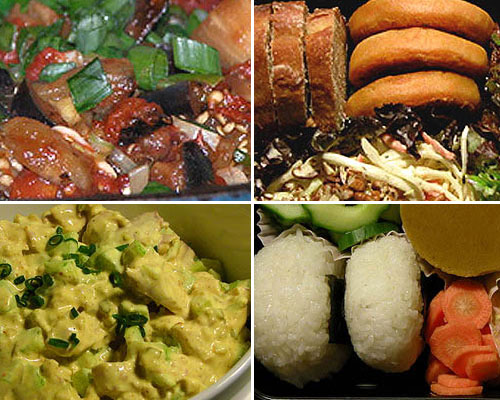
This is a guest post by Iliana (aka Mosaica), who blogs about her daily life at The Daily Mosaica.
In life I often find myself embracing contradictions, and with regard to planning and preparing bento lunches, it appears that I am, at least, consistent. At times I am purely focused on taking a given recipe, often a Japanese recipe, and rendering it as authentically as possible given the constraints of my semi-rural existence in Vermont, a small state in the northeast of the US. For instance the bento from last week where I made inarizushi -- this meal nourished me on a number of levels: it was completely delicious, it tied into a fascinating bit of cultural history, and it expanded my culinary repertoire. While I do miss the days when I was more of a globe-trotter, I've come to really appreciate how traveling via recipes from far, far away can give real pleasure --to my nose and eyes and tastebuds, as well as to my intellectual bits.
On the other hand, I'm also a bit of a fiesty girl, and I like to kick up my heels, as it were, in the kitchen, and for me this manifests itself as a willingness to play with food, to be led by my nose, or intuition, or a gut feeling that mixing this with that might just be yummy. That's what this post is about: Taking ingredients which are traditional in Japanese cuisine and dressing them up in flavors from around the globe: Tibet, Denmark, Africa, India, and beyond. In addition, if you start from a perspective of your own preferred ratio of carb to protein to veggies and fruit, I encourage you to include entirely new ingredients to add fresh flavor and interest to your bento meal. During the five weeks of the Bento Challenge, I was inspired to see how many of us were using foods and flavors from our own backyards to create delicious new twists on the bento theme.
Recipe: Tibetan Ratatouille
Eggplant (aubergine) is certainly a beloved food in Japan, and is indeed popular the world over. It shows up in many bento meals either as a main vegetable component, and sometimes in the form of delicious-looking pickles.
A few weeks ago I was inspired by a fellow Bento Challenger when she shared a beautiful eggplant dish in her bento. I looked for the recipe for her dish, but she hadn't posted it yet, so I took a look at my own cookbook shelf. I went first to the most recent cookbook by my favorites Jeffrey Alford and Naomi Duguid, Beyond The Great Wall: Recipes and Travels in the Other China. A little page flipping and I was sold on their recipe for Tibetan Ratatouille, and I set about making it. It turned out great, and was visible in nearly a week's worth of bento lunches.
Here's the recipe, liberally adapted and warmly shared with the permission of Naomi:
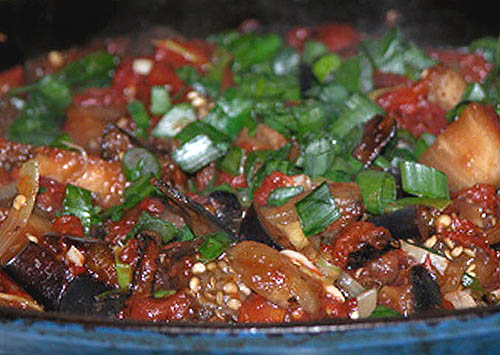
Makes approximately six cups of ratatouille. I kept half of it in the fridge and ate it in bentos and for dinner within a week, and I still have six half-cup portions in the freezer as a tasty addition to my johbisai.
- 1 large oval eggplant, around 1 1/2 lbs
- 1 28 oz (800g) can of whole peeled tomatoes, juice drained and reserved for another purpose
- 8 scallions (green/spring onions)
- 2 tablespoons peanut or olive oil
- 2 tablespoons minced garlic
- 2 tablespoons minched ginger root
- 2 teaspoons salt, or to taste
- 1/2 teaspoon ground Sichuan pepper (山椒or Sanshō in Japanese)
- 1/2 cup mild chicken, vegetable, or meat broth
- 2 tablespoons soy sauce, or to taste (I used closer to 4 tablespoons)
Trim eggplant and cut into 1.5 inch or bite-sized pieces, and set aside. Put the whole tomatoes into a large bowl and use scissors to chop into bite-sized pieces, an inch or so. Drain the extra juice that will have spilled out of the tomatoes and add the juices to the other juices you drained away. Trim the scallions and set aside the green parts. Cut the white parts into 1.5 to 2 inch lengths, and then lengthwise into ribbons, and set aside. Mince the scallion greens fine, and set aside.
Place a large wok or heavy skillet over high heat. I use a well-seasoned cast-iron wok, and I find this works well with a reasonable amount of oil, and I imagine that a large cast-iron skillet would work equally well. Eggplant can have a tendency to stick, but with vigorous stir-frying using a wok paddle and high heat, I never have problems.
Swirl oil to coat the surface of the pan and add the eggplant. Toss and stir so the oil is evenly distributed, and press the eggplant against the pan to scorch all the surfaces. After 3 or 4 minutes add the minced garlic and ginger. The original recipe calls for adding the garlic and ginger first, but I find it can burn too quickly, before the eggplant is sufficiently browned, so this switch works well for me.
Add 1 teaspoon of the salt and stir-fry for another minute or two, and then add the chopped tomatoes. Stir-fry for a minute or two, until the tomatoes are warmed and soft. Add the scallion ribbons and stir-fry to mix. Add the Sichuan pepper and the remaining teaspoon of salt, and stir-fry for another minute. Add the broth and stir-fry until it comes to a boil. Cover and boil hard for for 3 or 4 minutes. Uncover, stir, and taste the eggplant for doneness. I cooked it a little longer because I wanted a less saucy final dish. When the eggplant is tender to your taste, add the soy sauce and the minced scallion greens, stir, and taste for seasoning. I know I added an additional few splashes of soy sauce, and a pinch more of salt.
This is delicious hot or cold, and it goes particularly well with the nutty goodness of brown rice. I also enjoyed this in a bento lunch alongside spicy coleslaw, a few potato/sweet potato oyaki, and good mom bread.
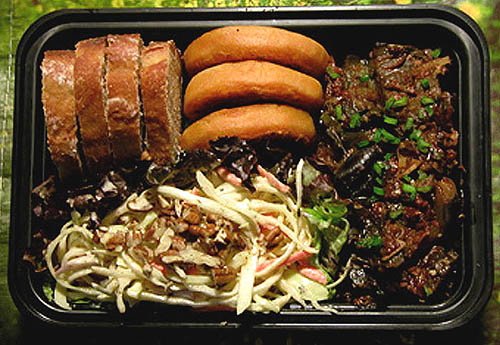
As a note, I kept all that good tomato juice and used it in a vegetable stew a few nights later. It freezes well.
Recipe: Curry Chicken Salad
Chicken is another favorite the world over. Maki recently published a tasty recipe for chicken skewers, and I had a whole small chicken to use. I had planned to cut off skewerable pieces from the breast and then boil the rest for soup, but I got busy, and when I looked into the fridge a few nights ago, I saw that I needed to use that chicken right then! It was late, and I was tired, so went with an old favorite: simple roast chicken, sprinkled with salt and served with no more than fresh butter, a little mound of mustard, and some of mom's crusty bread. That was good, and I had left over chicken! I picked the good bits of chicken off, and gently boiled the carcass for soup broth, cooled it, and into the freezer it went.
The next day I came up with a delicious way to use the cooked chicken in my bento: a curried chicken salad. I was inspired by an amazing documentary series about the history of India, and this salad is fragrant, lush, and golden.
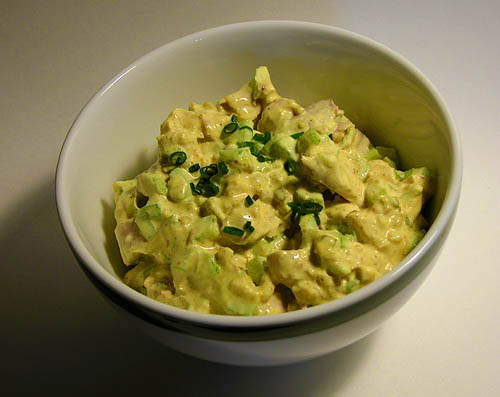
This recipe makes around 2 cups of salad, enough for a couple of bento lunches and leftovers for a quick & easy dinner for two.
- 1.5 cups roasted chicken meat, skin removed, chopped into 1/2 inch pieces
- 1/3 to 1/2 cup mayonnaise, to taste --I like mine not too wet
- 2 medium stalks celery, each sliced lengthwise in three, and then chopped fine
- 1 generous tablespoon prepared sweet relish or finely chopped pickled cucumbers (sweet, bread & butter, etc)
- 1 generous teaspoon sweet curry powder. I used a saffron-heavy one called Majarajah which I like
- 1/2 teaspoon turmeric (both for flavor and for even more glorious gold-yellow colour)
- 1/2 teaspoon salt, to taste
- 1/4 teaspoon ground pepper --ground dried green peppercorns are especially nice a bit of finely sliced scallion greens or chives for a flavourful garnish
Chop chicken into 1/2 inch pices and place in a bowl. Add the mayo, the celery, the relish or chopped pickles, the sweet curry powder, turmeric, salt, and pepper. I happen to really love peppery chicken salad, so I added an additional big pinch of ground pepper. Mix well, and enjoy with bread, crackers, or atop a green salad or even a simple carrot salad. Add a touch of contrasting colour with a sprinkle of chives or scallion greens.
I made a delicious bento lunch based on this chicken salad with two small plain onigiri, some sunomono salad, a small carrot cut into rounds, a few cashews, and a delicious pumpkin and coconut milk panna cotta, set with agar agar, which I learned over at Chez Pim. Not pictured were the 10 Wheat Thins (crackers) I ate with the chicken salad.
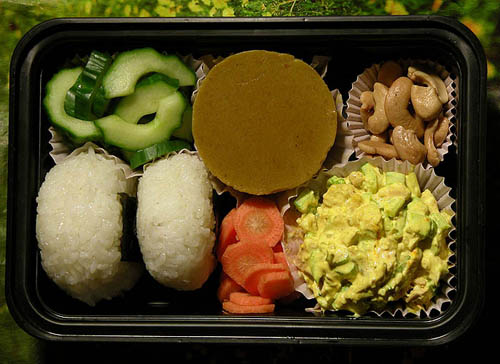
This kitchen-travel style of cooking adds adventure to my life, and it's wonderfully adaptable to each of our own particular set of food enthusiasms. It allows you to take inspiration from afar and apply it to your locally available food, or vice versa --try adapting some of your favorite family recipes to one of the new strange foods you find at your market; the possibilities are literally endless. I hope you enjoy these recipes, and I look forward to seeing how you might hack them to reflect your own culinary travel dreams via bento lunches. I'm off to try a Senagalese recipe that I heard about on The Splendid Table, a cooking program on public radio here in the US. It utilizes a grain little-known outside of Africa called Fonio, and I think it will make an excellent new carb in an African-inspired bento!
If you enjoyed this article, please consider supporting this site by becoming my patron via Patreon.
